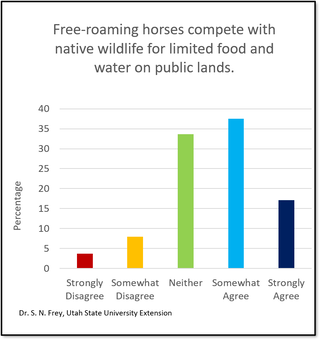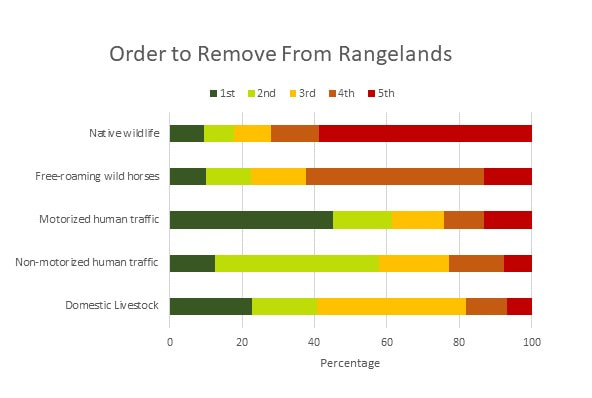Introduction
In 2019, the Cooperative Extension System and Agricultural Experiment Stations in Utah and Nevada initiated a Rapid Response Team to focus on free-roaming horse and burro management. This team is made up of specialists from 5 western states that study free-roaming horse biology, ecology, and management, rangeland ecology, and human-wildlife conflict management. The goal of the team is to provide service and momentum to aid the Bureau of Land Management and the US Forest Service in creating a successful free-roaming horse management program for the future. A subcommittee was formed to create a national public survey to gauge the public’s knowledge and opinions of wild horses. Members of the State of Utah, the Bureau of Land Management Wild Horse and Burro Program, and the US Forest Service regional ranger, and scientists involved in studying free-roaming horses reviewed and supported the survey prior to its launch.
The following information represents the results of the opinion-based questions of our survey.
Please go to the page entitled "Public Knowledge and Opinion of Free-roaming Horses" for the results of our knowledge-based questions.
We are still analyzing our data. We will continue to update our results here as they are vetted by our team of scientists and published.
The following information represents the results of the opinion-based questions of our survey.
Please go to the page entitled "Public Knowledge and Opinion of Free-roaming Horses" for the results of our knowledge-based questions.
We are still analyzing our data. We will continue to update our results here as they are vetted by our team of scientists and published.
Competition on the Rangelands
How much the United States federal land managers should manage free-roaming horses is a matter of great concern. As a species that is protected by law, the Bureau of Land Management and the U. S. Forest Service are required to manage the populations of horses to be in balance with the other species that live on these federal lands, as well as other human uses of federal lands - grazing livestock, recreation, and energy resources, to name a few.
It is important to consider that ALL HOOFED animals in the United States are managed in some way, whether they are wild, feral or domestic. Managing horse, moose, elk, deer, wild sheep, domestic sheep, goats, pigs, and cattle numbers is the only way to ensure a balance among the health of these animal populations, reduced competition among them, the health of the habitat in which they live, and the needs and wants of the U. S. citizens. Without management, conflicts are inevitable.
For more information about the potential conflicts that can arise between horses and wildlife, read this short article: Horse and Wildlife Interactions
It is important to consider that ALL HOOFED animals in the United States are managed in some way, whether they are wild, feral or domestic. Managing horse, moose, elk, deer, wild sheep, domestic sheep, goats, pigs, and cattle numbers is the only way to ensure a balance among the health of these animal populations, reduced competition among them, the health of the habitat in which they live, and the needs and wants of the U. S. citizens. Without management, conflicts are inevitable.
For more information about the potential conflicts that can arise between horses and wildlife, read this short article: Horse and Wildlife Interactions
|
About 50% of the U.S. public agrees that free-roaming horses compete with native wildlife, cattle, and livestock for food and water in our western rangelands. However, about a third of the U. S. public isn't sure. As a hooved mammal free-ranging on federal and state public lands, horses compete with all other mammals, birds, and reptiles that need grass to eat and water to drink. In the last few years, the western U. S. has been experiencing a drought. This means water is hard to find, increasing the competition between horses and native wildlife species. |
|
When competition is threatening the lives of horses, native wildlife, and cattle, the federal land management agencies must re-balance the multiple users of public lands. We asked respondents to indicate which users should be removed first, second, etc. Most users indicated that motorized human traffic should be removed from the landscape first, while native wildlife should be removed from the landscape last. Free-roaming horses should be removed before native wildlife populations are reduced. |
Our Research is Published!
This website has the most comprehensive information about our research project. However, we are also publishing our data in peer-reviewed journals. You are welcome to download and read our article on the public opinion of reproductive control options in the Human-Wildlife Interactions Journal: "U.S. Public Opinion of Reproductive Control Options for Free-roaming Horses" by S. Nicole Frey, Jeffrey L. Beck et al. (usu.edu)
This page will be updated periodically with new information. Last update September 2023
For more information contact Dr. Nicki Frey, [email protected]
For more information contact Dr. Nicki Frey, [email protected]



